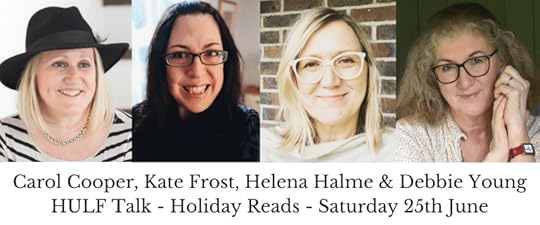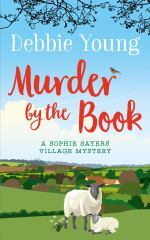Debbie Young's Blog, page 13
August 17, 2022
Me & My Mini #5: Lizzie Lamb
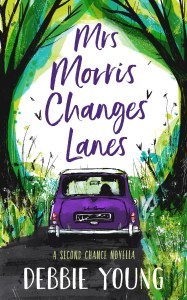 The cover of my novella, hand-drawn by Rachel Lawston, depicts Mrs Morris driving off into the unknown in her magical purple Mini …
The cover of my novella, hand-drawn by Rachel Lawston, depicts Mrs Morris driving off into the unknown in her magical purple Mini …Although I’ve never driven a Mini, as a child of the Sixties, I can’t help but be charmed by this iconic car design, with its distinctive personality. That’s why I chose it to take Juliet Morris on her life-changing journey in my romantic comedy novella, Mrs Morris Changes Lanes.
Writing that story also made me curious about why so many of my author friends have chosen to drive a Mini, hence this occasional guest post series in which one of them tells the story behind their Mini.
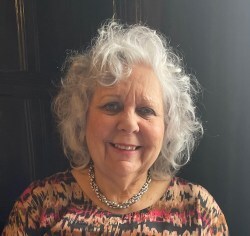 Meet Lizzie Lamb, romantic novelist and Mini driver
Meet Lizzie Lamb, romantic novelist and Mini driverToday I’m pleased to welcome Lizzie Lamb, whose romantic novels are based in the Scottish Highlands, a setting close to my heart too. Over to Lizzie…
***
Hello Lizzie and welcome! Please tell us, why and when did you buy your first Mini?
My/our first Mini wasn’t a Mini at all. It was a Wolseley Hornet (posh Mini) which my husband’s family bought him when he went to teacher training college in 1969. The reason I was attracted to him was because he was one of the few students who had a car. (Just kidding). I stayed with him long after the car went to the scrap yard and spent most of my grant keeping it on the road. So, it must have been love. LOL.
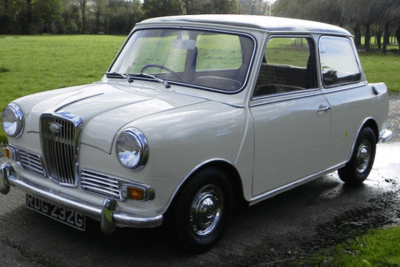 Not quite a Mini, but nearly
Not quite a Mini, but nearlyOur second mini we saw advertised in a newsagent’s window. Its elderly owner had passed away and it was free to a good home. We took it home, looked after it and then sold it on to an enthusiast years later.
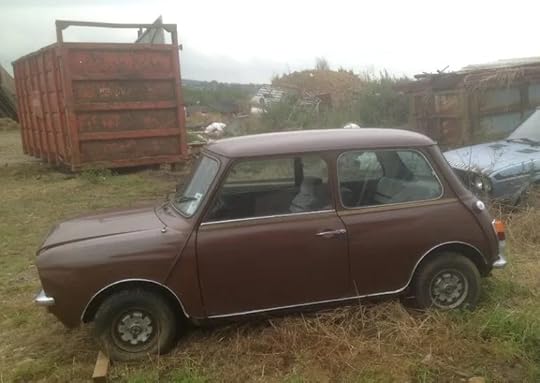 Given a new lease of life after its previous owner’s death
Given a new lease of life after its previous owner’s deathMy car then was a Golf VR6 Automatic – a rare beast, and went like a rocket.
Our third Mini is mine, all mine.
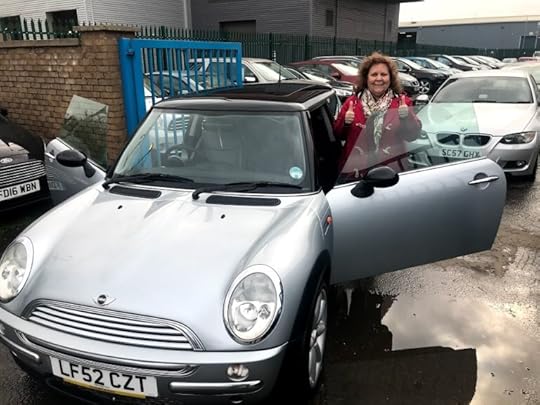 Third time lucky!
Third time lucky!We bought it from a dealership in the Fens and it cost £2,500. I wanted a Mini Cooper with all the bells and whistles but couldn’t afford a Cooper-S. This fitted the bill.
Please describe it in as much detail as possible.
The only extras were Mini mats and a shoulder strap to stop the seat belt from rubbing on my collar bone. It came with two electric sunroofs, CD player, climate control, CD stacker and somewhere to plug in our cool box when we go off for picnics. My husband likes tinkering with cars so he got the climate control, door locks and reversing sensors working properly.
Due to the massive hike in petrol prices, we now go everywhere in my Mini and keep his Nissan El Grande for towing the caravan and his Triumph Stag for high days and holiday when the sun comes out.
Many Mini drivers seemed to feel compelled to name their Minis, as if they have a personality of their own. What was yours called?
As a writer of romantic fiction, I felt compelled to name mine: Jilly Cooper.
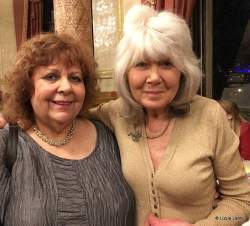 Lizzie (left) with fellow author Jilly Cooper at a Romantic Novelists Awards ceremony in 2018
Lizzie (left) with fellow author Jilly Cooper at a Romantic Novelists Awards ceremony in 2018I met Jilly in 2018 at an RNA awards ceremony and she was everything I hoped she would be, she signed my book and wished me well. #fangirl
 The four-wheeled Jilly Cooper!
The four-wheeled Jilly Cooper!What is it about Minis that makes most owners feel so attached to them?
I think because they are iconic, steeped in history and great to nip about it. They are reminiscent of The Italian Job, the Swinging Sixties and models learning to get out of them without showing their lingerie to all and sundry.
Mine is an automatic and, should I win the Lottery, I would probably upgrade to a Mini Cooper-S or a Countryman.
What do you most love about your Mini?
How ‘nippy’ and economical it isOur original one could turn on a sixpenceThe fact that you can park it just about anywhereIt fits on our very short driveOddly enough, two of our neighbours have almost identical Minis to mine and we kept saying that we’re going for a burn up on the A6 before we get too old.
What drives you nuts about it?
It’s a very ‘hard’ ride, the side impact doors are heavy and difficult to close, and there is no handle above the front passenger or driver seats to help me in and out of the vehicle.Every time I push the front seat forward a warning light comes on and has to be reset or it’ll fail its MOT.The sunshade is pathetically small and I have to wear my ‘Bill and Ben’ hat to shade my eyes from the sun.Where did your longest journey in your Mini take you?
It was in our Wolsey Hornet, actually. As students, we drove from Grantham to Fort William, stacked to the gunwales with camping equipment and two passengers in the back. Happy days.
What was your most exciting trip?
Our trip round Scotland, because of how far we travelled each day and the sights we saw: Edinburgh, Loch Ness, Inverness etc. I love history and the fact that we were able to visit Marston Moor, the site of a Civil War battle, en route to Scotland made the trip for me.
Did you ever have any accidents or any scary trips in your Mini?
We bought my Mini from a dealership on the Fens. When we took it for a test drive, we pulled into a layby to check out the controls etc.
A blacked-out Range Rover pulled alongside, a man lowered the window and offered us drugs. That’s what being in a Mini will lead to . . .
Once, when we travelling along a dual carriageway and yanked on the handbrake, it came off in our hands, and we hurriedly had to pull in to a layby.
Also, I have a huge phobia about wasps and that’s why I can’t drive a convertible. Even so, a queen flew in through the open sun roof and I nearly crashed the Mini in my panic to escape from it.
Who was your favourite/most interesting/most difficult passenger and why?
My most interesting passenger was our parrot who went everywhere with us in a large ‘cat box’. He would chatter away nineteen to the dozen and join in with the music I played on the CD stacker. Not real words, naturally, although he did sing along with ‘What you gonna look like with a chimney on you’. I don’t know why that song appealed to him but it did.
My most difficult passenger is someone I used to give lifts to. However, she was never on time and was often horrendously late, making me late in the process. In the end I stopped giving her lifts because, as a very punctual person, I found her behaviour disrespectful and highly irritating.
What car do you drive now?
I still drive my Mini Cooper. I bought personalised number plates when I had my VW Golf and I’ve put those on my Mini. LI7 VWG almost looks like Liz, right?
What would be your dream car if money were no object?
For towing our 25 ft caravan, probably a Kia Sorrento or VW Tuareg.For everyday travelling, probably a Range Rover.As for Minis, a top of the range one with all the bells and whistle in either British Racing Green with go-faster stripes or purple like Mrs Morris’s.If you’ve read Mrs Morris Changes Lanes , what did you think of her Mini and of her adventure?
I really enjoyed it. I’ve never read Magical Realism before. I preferred her magic Mini’s sat nav to mine (I use Google Maps on my iPhone).
Her Mini was a dream and I’d quite like one of those.
I also fancy a purple mini as it would match my novel covers. My favourite part was at the end of the novella. I love second-chance love stories.
What most surprised you about your Mini?
The fact that most people seem to have a soft spot for Issigonis’s classic and are keen to share their Mini stories with me.
Lizzie, thank you for sharing YOUR story of many Minis with me!
For anyone interested in sampling Lizzie’s romantic fiction, all set in Scotland (perhaps inspired by her favourite trip in her Mini!), Scotch on the Rocks is a great starting point.
Ishabel Stuart is at the crossroads of her life. Her wealthy industrialist father has died unexpectedly, leaving her a half-share in a ruined whisky distillery and the task of scattering his ashes on a Munro. After discovering her fiancé playing away from home, she cancels their lavish Christmas wedding at St Giles Cathedral, Edinburgh and heads for the only place she feels safe – Eilean na Sgairbh, a windswept island on Scotland’s west coast. When she arrives at her family home – now a bed and breakfast managed by her left-wing, firebrand Aunt Esme, she finds a guest in situ – Brodie.
Issy longs for peace and the chance to lick her wounds, but gorgeous, sexy American, Brodie, turns her world upside down. In spite of her vow to steer clear of men, she grows to rely on Brodie. However, she suspects him of having an ulterior motive for staying at her aunt’s Bed and Breakfast on remote Cormorant Island. Having been let down by the men in her life, will it be third time lucky for Issy? Is she wise to trust a man she knows nothing about – a man who presents her with more questions than answers? As for Aunt Esme, she has secrets of her own . . .
To order your copy of Scotch on the Rocks, click here.
Find out more about Lizzie Lamb and her books, click here.
To order your copy of Mrs Morris Changes Lanes, click here.
Previous Posts in this Series
August 13, 2022
You Are What You Wear
 Askeuhd, CC BY-SA 4.0 <https://creativecommons.org/licenses/by-sa/4.0>, via Wikimedia Commons
Askeuhd, CC BY-SA 4.0 <https://creativecommons.org/licenses/by-sa/4.0>, via Wikimedia CommonsLast week as I was having lunch at a restaurant in Bristol, a young astronaut wandered by.
Clutching her father’s hand, she was about four years old. A little young, you might think, when the minimum prerequisites for this career include a science degree and a thousand hours’ experience as an aircraft pilot-in-command.
But all this little girl needed to believe she was an astronaut was her white nylon jumpsuit with its distinctive NASA badges and its metal collar to clip the helmet on.
She had left the helmet at home because it was a hot day.
Whenever I see a small child in fancy dress, I’m touched by how completely it transforms their self-image. It instantly turns them into whatever they want to be. It’s the same brand of imagination that allows them to sail the seven seas in an empty laundry basket or career around a racing track in a large cardboard box.
The little girl’s astronaut outfit made a refreshing change from the more common princess gowns and fairy costumes.
It was good to see a child aspiring to be something that involved academic qualifications rather than accidents of birth.
Aged four, I wanted to be a nurse when I grew up, primarily because I liked the uniform. I particularly craved a real upside-down watch like the one printed on the tunic of my dressing-up set. When for the school Christmas party the teachers offered to make us crepe-paper hats of our own design, I requested a nurse’s hat. Yes, in those days nurses still wore hats, à la Florence Nightingale, heroine of my favourite Ladybird history book, before they were abolished for reasons of infection control.
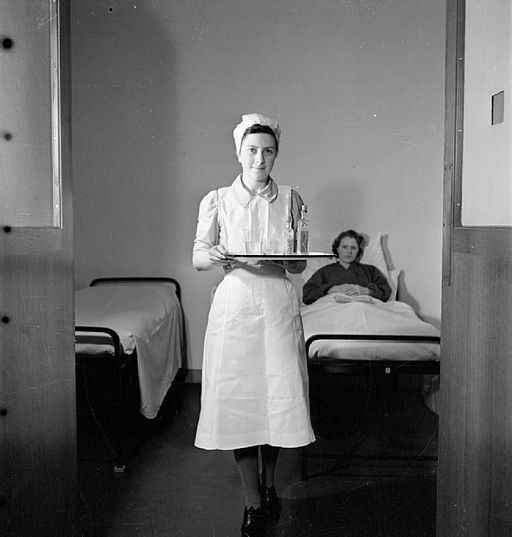 Photo by Richard Stone, Public domain, via Wikimedia Commons
Photo by Richard Stone, Public domain, via Wikimedia CommonsHowever, they’d run out of white crepe paper, so they made me a hideous yellow hat instead.
The disappointment was enough to end my medical ambitions.
Next I wanted to be a librarian because I wanted to be able to play all day long with the tools of the trade of the pre-digital library: rubber date stamps, cardboard library tickets filed alphabetically in big boxes behind the counter, and index cards in wooden cabinets. A few years ago I acquired a vintage two-drawer library filing cabinet which now sits under my computer monitor. It gives me pleasure every time I look at it.
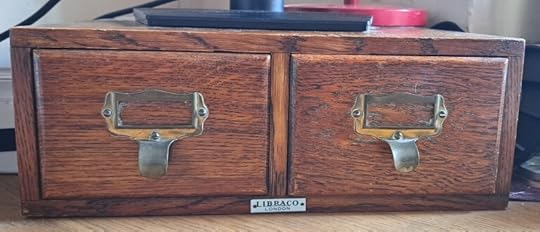 In pride of place on my desk, beneath my computer monitor – old technology propping up the new
In pride of place on my desk, beneath my computer monitor – old technology propping up the newOnly when I was five, when the headmistress made me read a story I’d written to the rest of the school, did I realise that being an author was a viable career option. What was more, I could wear any colour hat for it that I liked. Funnily enough, I’ve had people say to me when seeing me after an author event that they almost didn’t recognise me without a hat. It’s only just occurred to me that my disappointment over the yellow nurse’s hat could be the subsconscious reason I now favour so many different coloured hats.
“Find a job you enjoy doing, and you’ll never have to work a day in your life,” said Mark Twain, and he was right.
I’ve been lucky to find such a job myself (and such a wide array of suitable hats), but not everyone is as fortunate, no matter how clever or well qualified. Some years ago I read a newspaper report about an infant prodigy who had achieved her Maths A Level at the age of 8. When the journalist asked what she wanted to be when she grew up, she replied, “A mermaid”. I hope her pushy parents had the heart to buy her a mermaid outfit, wherever their ambitions for her lay.
 Waterhouse, John William; A Mermaid; Royal Academy of Arts; http://www.artuk.org/artworks/a-mermaid-149322
Waterhouse, John William; A Mermaid; Royal Academy of Arts; http://www.artuk.org/artworks/a-mermaid-149322This post was originally written for the August issue of the Hawkesbury Upton Parish News
IN OTHER NEWSIn case you haven’t heard, this summer my writing career has entered a transformational stage, as I move from publishing my own novels via my imprint, Hawkesbury Press, to licensing the rights to trade publishing companies. After many months of planning and negotiating, I’m pleased to announce the release schedule of the following new editions via three different publishers.
BOLDWOOD BOOKS will be reissuing new editions of all my novels, as part of a 13-book contract, with new cover images and in some cases new titles.
My two novels set at St Bride’s School are being rebranded as the Gemma Lamb Cozy Mysteries.
Secrets at St Bride’s will become Dastardly Deeds at St Bride’sStranger at St Bride’s will become Sinister Stranger at St Bride’s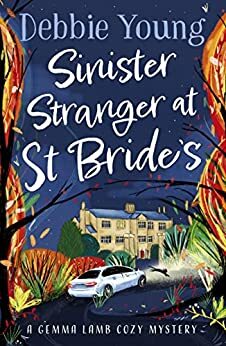

They will be joined by a completely new third book in November, Wicked Whispers at St Bride’s, of which the cover is still under wraps.
DP VERLAG, a German language ebook specialist, has licensed the rights for the German translations of the first three in my Sophie Sayers series, of which it has now published the first:
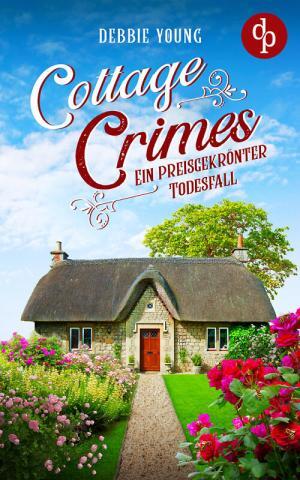
SAGA EGMONT, a specialist in audiobooks, will be publishing all seven of my Sophie Sayers novels in audio format, and it’s already started with Best Murder in Show.
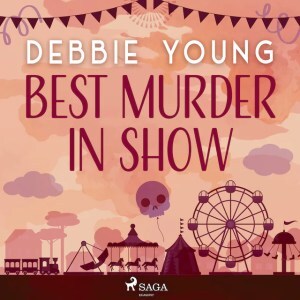
Meanwhile, I’m working hard on my next book – the eighth Sophie Sayers Village Mystery, working title A Fling with Murder, in which Sophie takes Hector to meet her parents in Scotland, via Gretna Green!
July 20, 2022
All Fall Down
Preparing to visit Berlin for the first time a few weeks ago, I was unsure what I might find there.
My expectations had been partly shaped by a blend of fiction (Isherwood), film (Cabaret), and song, (Bowie’s “We Can Be Heroes”).
 The jaunty tunes played by this organ grinder in front of the magnificent Brandenburg Gate reminded me of the Berlin of Isherwood’s time
The jaunty tunes played by this organ grinder in front of the magnificent Brandenburg Gate reminded me of the Berlin of Isherwood’s timeAt school I studied twentieth century history to A Level. In those days, the Berlin Wall was an impenetrable barrier between East and West, and I was living in Frankfurt with a postal address in West Germany.
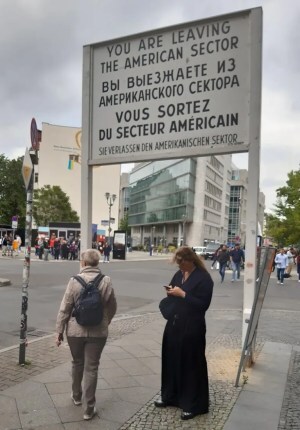 When I lived in Germany as a teenager, the Berlin Wall was still standing. This iconic sign that divided the American sector from the Russian remains as a chilling reminder, though this tourist seems unfazed.
When I lived in Germany as a teenager, the Berlin Wall was still standing. This iconic sign that divided the American sector from the Russian remains as a chilling reminder, though this tourist seems unfazed.Packing for our city break, I discarded the book I’d been saving to read on the trip: a historical novel set in Berlin during the Second World War. Might it be offensive to be seen reading a story about an era Berliners would prefer to forget?
I need not have worried.
The city turned out to be full of reminders of both World Wars and the Cold War, now serving as incitements to peace.
 Beside the bombed ruins of the bell tower of the Kaiser Wilhelm Church now stands beside a modern bell tower as a symbol of peace.
Beside the bombed ruins of the bell tower of the Kaiser Wilhelm Church now stands beside a modern bell tower as a symbol of peace.Even parts of the hated Berlin Wall have been left standing. When the Wall fell in 1989, Berliners resisted their initial impulse to destroy the whole of this brutal divider of East and West. Instead, they kept parts of it intact as a reminder of the importance of the freedom and democracy which the Wall once denied them.
 Sections of the Berlin Wall forming an educational display for passers-by
Sections of the Berlin Wall forming an educational display for passers-byThe rest of it was to be painted by local artists, then broken up for sale as souvenirs. The Wall was so huge that there are still plenty of pieces to meet tourists’ demands, and they must be a healthy source of revenue for the city’s coffers.
Berlin is now an upbeat, creative and cosmopolitan place, full of green spaces, wide tree-lined boulevards and light.
Standing outside our hotel on the Kurfürstendamm (Berlin’s answer to London’s Bond Street), we could hear not the roar of traffic, but copious birdsong.
 Where we stayed
Where we stayedThere are very few motorists, because Berlin’s public transport system is so efficient and affordable that you don’t need a car to get around. Their trams, trains, U-bahns and buses are also very easy to use. There are no ticket barriers anywhere, as it’s assumed all travellers will be honest and buy tickets. This trust may not be misplaced, according to Lenin, who joked, “If Germans ever stormed a railway station, they’d first buy a platform ticket.”
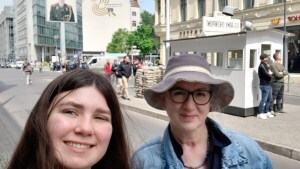 With my daughter by the iconic Checkpoint Charlie
With my daughter by the iconic Checkpoint CharlieAs in British towns, electric scooters are rife. The abundance of cycle paths in this flat city allows them to operate relatively safely. I wish I’d been quick enough with my phone camera to capture a sight that seemed to epitomise twenty-first century Berlin: a stream of electric scooters gliding freely past Checkpoint Charlie, still maintained as a landmark, into what used to be East Berlin.
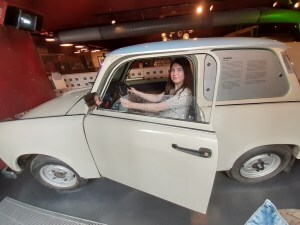 Testdriving an iconic Trabant was a highlight of our visit to the wonderful DDR Museum
Testdriving an iconic Trabant was a highlight of our visit to the wonderful DDR MuseumI had an unfortunate encounter with an electric scooter near the Brandenburg Gate, when I tripped over one left lying on the pavement. The scar on my left knee was an unwanted souvenir. But I also brought back a much better souvenir: a piece of the Berlin Wall, which now sits on my desk as a permanent reminder to myself that no obstacle is truly insurmountable. Except that electric scooter by the Brandenburg Gate, obviously.

This post was originally written for the July 2022 issue of the Hawkesbury Parish News
 I was thrilled when L J Ross chose my story inspired by the Berlin Wall for inclusion in her charity anthology…
I was thrilled when L J Ross chose my story inspired by the Berlin Wall for inclusion in her charity anthology…If you enjoyed this piece, you might enjoy this short story I wrote a couple of Christmases ago as a guest post for Helen Hollick’s blog, in which a souvenir of the Berlin Wall plays a crucial part: Christmas Ginger. It was later selected for L J Ross’s Everyday Kindness anthology in aid of Shelter, the charity for those without homes or in poor housing, and in the audiobook edition it was read by the distinguished actress and novelist .
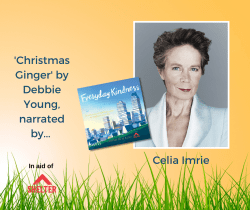 …and when Celia Imrie was chosen to narrate my story for the audiobook version edition.
…and when Celia Imrie was chosen to narrate my story for the audiobook version edition.
July 13, 2022
In the Eye of the Beholder
Who lives for 30 years within walking distance of Badminton Horse Trials without ever going to see them? Me, actually. Until now, neither the horses nor the shopping have tempted me, because horses and crowds, and indeed crowds of horses, leave me cold.
Then this year, singing in the choir at Great Badminton Church on the Sunday of my 31st Horse Trials weekend, I begin to see horses in a new light when the visiting preacher channels his inner Gerard Manley Hopkins and St Francis.
Now there’s great starting point for a fantasy dinner party guest list.


He talks about seeing God in nature and, in particular, in the energy and vitality of the horse. When he puts it like that, whether or not the horse’s maker is God, I can’t help but appreciate the end product. Strolling back to my car, I’m admiring not the power of the stable hands’ electric bikes which had earlier caught my eye, but the perfect engineering of the horses in nearby fields.
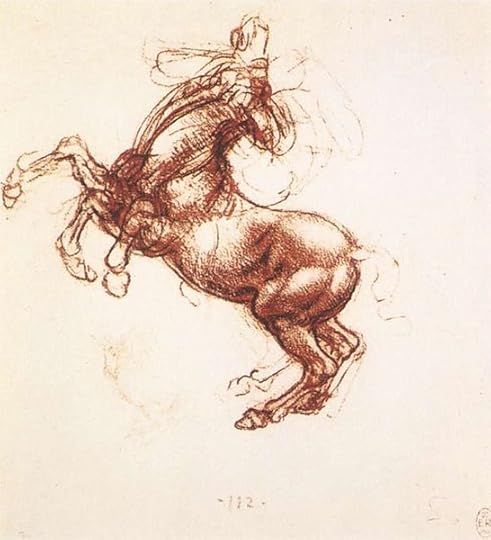 Leonardo da Vinci was also fascinated by horses and sketched them repeatedly (image here from Wikimedia Commons – Public Domain)
Leonardo da Vinci was also fascinated by horses and sketched them repeatedly (image here from Wikimedia Commons – Public Domain)This sense of wonder soon spreads to other things, notably a carrier bag of organic vegetables given to me by my niece after inadvertently duplicating her family’s veg box order. Emptying the bag onto the kitchen table, I discover a high-fibre art gallery: a knobbly hand of ginger in a neat cotton string vest; the perfectly furled leaves of a white cabbage; the proud, straight seams on stalks of celery; and much more.
My father first drew my attention to the extraordinary patterns known as Fibonacci numbers that occur naturally in certain flowers, fruit and vegetables. Googling Fibonacci – or as close as I can get to the right spelling – I’m reminded that this mathematical term describes a sequence in which each number is the sum of the two previous numbers.
0, 1, 1, 2, 3, 5, 8, 13, 21, 34, …
When petals or seedheads develop in this pattern, they look stunning. Perhaps the most familiar example is the array of seeds at the centre of a sunflower, but the most exquisite is the Romanesco broccoli, its florets tiny miracles.
 Photo by Ivar Leidus via Wikimedia Commons https://commons.wikimedia.org/wiki/User:Iifar
Photo by Ivar Leidus via Wikimedia Commons https://commons.wikimedia.org/wiki/User:IifarAlthough there’s no Romanesco broccoli in my gift bag, the contents are all beautiful in their own way. I consider signing up with the veg box supplier to relive this wonder every week. Then I reflect that in supermarkets I favour misshapen veg branded “wonky”, as if it were a virtue rather than failure to comply with their buyers’ stringent quality criteria. It’s like comparing a pedigree cat with a moggy. Which to choose?
As if on cue, Bertie, one of my three rescue cats, strolls by, chirruping a friendly greeting. With random black patches scattered over his long white fur, he’s more Jackson Pollock than Fibonacci, but I pick him up for a cuddle, telling him he’s beautiful too. I like to think Gerard Manley Hopkins and St Francis would have done the same. Besides, Bertie’s a lot easier to lift than a horse.
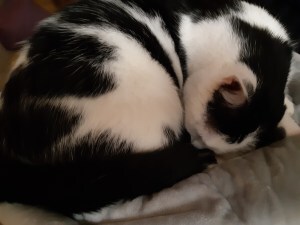
This post was originally written for the June edition of the Tetbury Advertiser.
July 6, 2022
The Silver and the Gold
In the wake of our national preoccupation with platinum, my thoughts have turned to silver and gold.
When I was eight years old, my family moved to the USA for a year to be with my father in his new job. I boarded the plane with Tiny Tears and Teddy in my arms, ready to embrace my new home and school with enthusiasm and an open mind.
While my older brother and sister refused to take part in the classroom flag salute with which every school day began, I got stuck in, hand on heart:
I pledge allegiance to the flag, and the United States of America, and to the Republic for which it stands, one Nation under God, indivisible, with liberty and justice for all.
A strange substitute for our comfortable daily religious assembly back home, sandwiching a quick prayer between two familiar hymns, but I wanted to fit in.
Before long, I’d made my Girl Scout Promise: “On my honor (sic), I will try to do my duty to God and my country, to help other people at all times, and to obey the Girl Scout laws.” Although I had to recite it only once, I remember the words far better, maybe because they chimed better with the gentle, apolitical hymns I was used to in assembly. Our school birthday hymn ended, “We hope you will be healthy and strong all the way; Strong to do right, slow to do wrong; and helpful to others all the day long.”
Another thing I learned as a Girl Scout was to sing this simple song in a round:
Make new friends, but keep the old;
One is silver and the other gold.
I rated my Girl Scout friends as silver, while my classmates back in England, at the school I rejoined a year later, were very much gold.
Six years later, we moved for four years to Germany, where I attended the Frankfurt International School with students from over sixty countries. It was time again to make silver friends. I kept in touch with the golden ones at home via numerous twenty-page letters handwritten on lurid stationery. Well, this was the 1970s.
In those days, long-distance friendships relied on such old-fashioned methods of communication. As we progressed through life, it was too easy to lose touch. Then along came the internet. Whatever else you think of social media, it’s a great means of tracing old friends. Thanks to Facebook, around the time of the Platinum Jubilee, I was able to welcome to my home here in the Cotswolds my old Canadian friend Debra, a classmate from Frankfurt International School.
We hadn’t seen each other in real life since the year of the Queen’s Silver Jubilee.
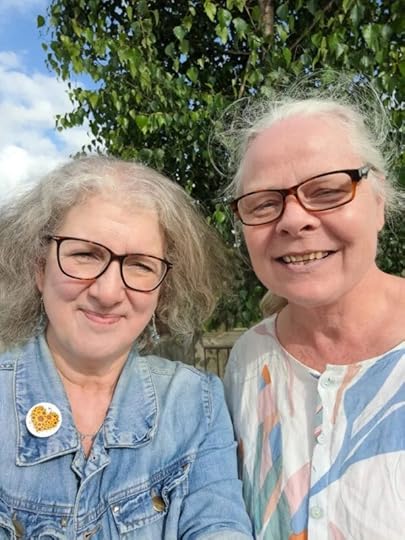 With Debra Esau, friends reunited this summer after 45 years
With Debra Esau, friends reunited this summer after 45 yearsWhat the Girl Scout song neglects to mention is that the alchemy of time eventually transforms silver friends into gold, and that meanwhile your hair may turn silver. But that’s a price I’m happy to have paid.
This post was originally written for the July/August edition of the Tetbury Advertiser.
June 30, 2022
Constant Comforts
This post first appeared in the June 2022 issue of the Hawkesbury Parish News, in the run-up to the Queen’s Platinum Jubilee – so please excuse the out-of-date final paragraph about that event.
Since joining the village choir and taking up bell ringing, I’ve been spending a lot more time in St Mary’s Church, and whenever I enter that ancient building, I feel a sense of calm that comes from being in a building that dates back over 1000 years. Its timelessness and permanence provide a helpful anchor in the midst of a busy life and a constant when everything else seems in flux.
I’d already decided on the topic for this month’s column when by a strange coincidence at church this morning the service included a prayer giving thanks for the constants in our lives, including the village school, the community shop and the pubs. It struck me as very Vicar of Dibley to say a prayer for the pubs (and very thankful we should be), but that may have been because our opening number at last night’s concert (which you can view on YouTube here) was the television show’s theme tune (Howard Goodall’s setting of “The Lord is my Shepherd” – you can listen to it here on YouTube).
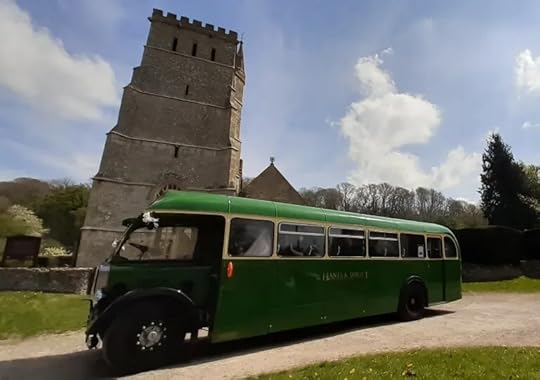 Seeing the bride and groom leave St Mary’s after their wedding with their guests in a vintage bus was another reminder of how little this part of the parish had changed – this picture could have been taken 70 years ago and there’d be no visible difference
Seeing the bride and groom leave St Mary’s after their wedding with their guests in a vintage bus was another reminder of how little this part of the parish had changed – this picture could have been taken 70 years ago and there’d be no visible differenceOf course, the church building is not entirely constant. It has evolved over the centuries and continues to do so, in small and large ways – from the installation of new energy-saving lightbulbs which might go unnoticed to all but the person signing off the electricity bill, to the very visible restoration of the tower and the installation of eight very audible new bells.
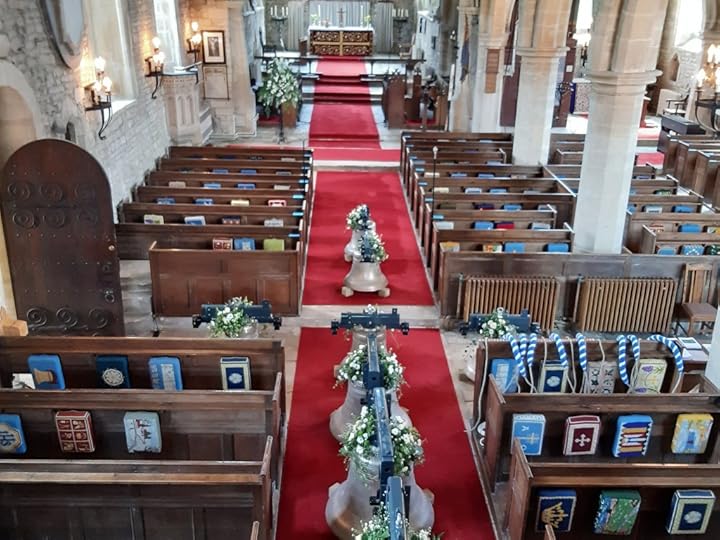 It was a privilege to be present at the blessing of our bells before they were installed in the tower last year
It was a privilege to be present at the blessing of our bells before they were installed in the tower last yearThe same goes for the built environment of the village: here a new extension, there a new house popping up in a spare bit of garden or a disused paddock, and sometimes, oh my goodness, along comes a whole new housing estate.
More subtle are the occasional changes of use, from barns and pubs and shops and places of worship to housing stock. The original purpose and many uses of the Methodist Chapel, which sadly closed at Easter, will be a treasured part of our collective memory for generations to come.
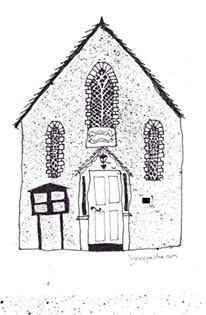 Image by Lynne Pardoe, a Hawkesbury Upton Literature Festival author
Image by Lynne Pardoe, a Hawkesbury Upton Literature Festival authorOnly when showing a visitor around the village recently did I realise just how much the built environment of the village had altered in the 31 years that I’ve lived here. Perhaps the degree of change has been slightly masked by the continuity that comes from a calendar of regular community events. While some are longstanding institutions, such as the Hawkesbury Horticultural Show (135 years old and counting), others are relative newcomers, such as HU5K (turning 10 this month) and HULF – the Hawkesbury Upton Literature Festival (now 7).
Speaking of longstanding institutions, this month we’ll be celebrating another one that belongs to this village as much as to anywhere else in the country: HM The Queen. As for most people in Hawkesbury, she’s the only monarch I’ve ever lived under. Whatever your feelings on the monarchy, the stability of having a long-serving head of state does provide a welcome contrast to the tumultuous comings and goings of our political leaders. Personally, I’m in no hurry to see a new face on our banknotes. There’s probably a joke in there somewhere about change (ho ho), but for now I’ll just wish you an enjoyable Platinum Holiday – another chapter of Hawkesbury history in the making.
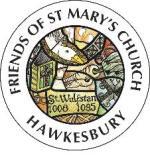
To find out more about St Mary’s, Hawkesbury, visit the Friends of St Mary’s website here: www.friendsofstmaryshawkesbury.com. New Friends are always welcome!
June 14, 2022
The Most Relaxing Holiday Destination
This post was first published in the May 2022 issue of the Hawkesbury Parish News, prompted by news headlines about numerous flight cancellations, but sadly a month later chaotic travel is still very much in the news!
Every year at the start of the holiday season, there is a sudden outburst of news reports of chaos at airports and ferry ports and on roads. This year, the disruption seems worse than ever as the travel industry struggles to scale up its operations after two long years in which venturing beyond the village seemed like a major excursion.
These scaremongering reports are enough to put anyone off travelling this spring, especially when so many people are returning from crowded travel hubs with the unwanted souvenir of Covid.
So here’s an alternative approach. This holiday season, why not spend your vacation in a delightful Cotswold location of which I’m very fond?
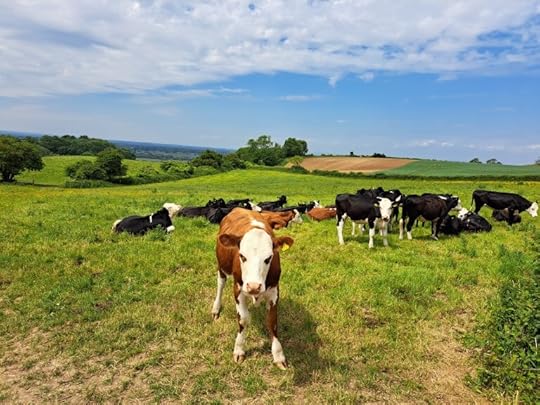 The natives are pretty friendly too
The natives are pretty friendly tooWith a fresh climate nurtured by its relative elevation, it offers stunning views across rolling hills and vales. Situated on a famous national trail and in an Area of Outstanding Natural Beauty, it provides a range of invigorating or gentle walks to suit all levels of physical fitness. Anyone seeking more strenuous physical activity may hire the local tennis courts at a very reasonable rate or, as a useful alternative in inclement weather, the village hall for badminton.
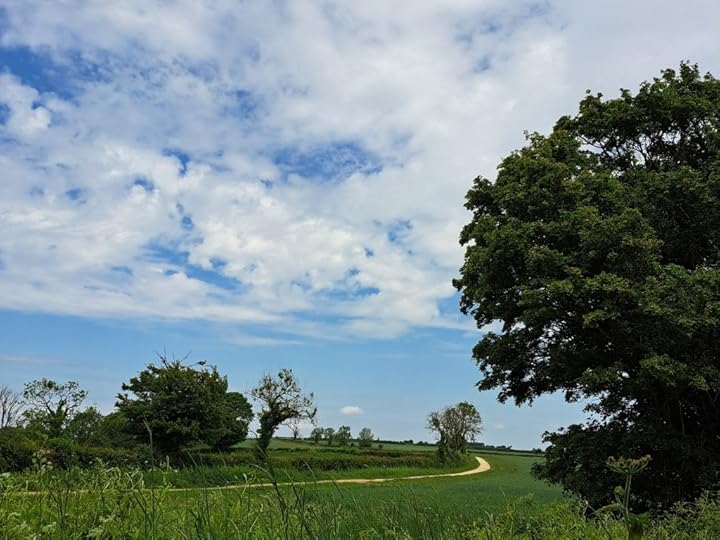 The section of the Cotswold Way that runs beside the village is affectionately called by locals The Yellow Brick Road
The section of the Cotswold Way that runs beside the village is affectionately called by locals The Yellow Brick RoadTwo local pubs and a well-stocked village shop give you the choice of dining out or self-catering. And what could be more relaxing than a summer afternoon picnicking on local produce at the village cricket ground, to the sound of leather on willow?
For younger visitors, the newly upgraded and expanded playpark, complete with zipwire, provides ample entertainment, while the skatepark and basketball court will please teens.
Those who prefer to relax in a more sedentary manner may pick up as many books as they care to read, completely free of charge, from the Books on the Bus box in the bus shelter, or from the Post Cottage Little Free Library on France Lane. Available to buy from the village shop are new books by the many local authors – it’s a famously creative village. These books make great souvenirs, as do the local crafts, honey, attractively packaged sweets and home-made baked goods on sale there.
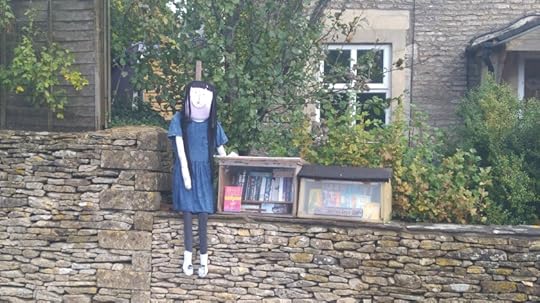 Matilda loves my Little Free Library!
Matilda loves my Little Free Library!All these appealing holiday facilities are available to you right now, without fear of queues or cancellations, and with zero environmental impact. The closest you are likely to find to a traffic jam is having to slow down for tractors or horses.
Welcome to Hawkesbury Upton. Just open your door and you’re there. We wish you a very happy holiday.
 The start of a whole new Cotswold adventure…IN OTHER NEWS…HULF Talk on Holiday Reads
The start of a whole new Cotswold adventure…IN OTHER NEWS…HULF Talk on Holiday ReadsWhether or not you are travelling abroad yourself this summer, if you live in or near the Cotswolds, you might like to come along to join me at the HULF Talk on Holiday Reads – the occasional series of Hawkesbury Upton Literature Festival talks featuring three guest authors speaking on a particular topic.
This time we’ll be talking about novels set all over the world by:
Carol Cooper , a medical doctor and journalist whose touching family mystery The Girls from Alexandria is set in the Egyptian city in which she grew up Kate Frost , whose latest romantic escape novel One Greek Summer is currently #25 in the Kindle UK chart, with An Italian Dream launching in July Helena Halme , a Finnish author of Nordic thrillers and romantic sagas such as The Red King of Helsinki and her Love on the Island seriesChairing the discussion, I will also be flying the flag for the Cotswolds, although I’ll also talk a bit about my sixth Sophie Sayers novel, Murder Your Darlings, set on a tiny fictitious island off the coast of Ithaca.
We’ll talk about what makes a great holiday read, the joy of travelling through the pages of a good book, and the challenges of creating an effective sense of place in fiction. The authors will also share the stories behind their novels, offer glimpses into their writing lives, and give readings.
As always, tickets will cost just £5 each, and for that you get all the tea, coffee and cake you can consume, plus a £2 book voucher redeemable on the day. Refreshments this time will be on a holiday theme – we will have fun!
Book Your Tickets HereDue to limited space at our delightful venue, the Bethesda Chapel in Park Street, Hawkesbury Upton GL9 1BA, please book your ticket in advance via Eventbrite here: https://www.eventbrite.co.uk/e/hulf-talk-holiday-reads-tickets-335988690217
May 11, 2022
On Track for the Holidays
A few years ago, my husband suggested we download an app* that keeps track of family and friends via their mobile phone signals.
He tends not to listen when I tell him where I’m going, and the most frequent message left on my mobile is from him, saying, “Debbie, where are you?”
He once called me on a Friday afternoon, concerned that our daughter was late home from school. My reply: “That’s because she’s here with me in the car, and we’re on our way to Cornwall for the weekend.” We had of course told him of our plans many times before we left.
While my husband was all in favour of the app, my daughter and I were not keen. It felt intrusive, like being microchipped or electronically tagged.
When the pandemic put paid to travel, we let the matter drop, but when we started to travel again this spring, and with my daughter planning some gap year adventures, we agreed to install the app for reassurance.
Our first chance to test it came in April, when my husband and daughter headed to the south of France for a week. As I’d made all the bookings, I felt personally responsible that everything should go smoothly, so I was glad to use the app to track their progress . With planes, trains and automobiles involved in their journey, there was ample opportunity for trouble – flight delays, cancellations and missed connections – even before we factored in my husband’s propensity to misplace his possessions.
Initially, following their progress on the app made me feel like a spy, but it soon became enjoyable and absorbing, although the intermittent phone signal made it slightly unreliable.
Often they appeared to be in two different places, even when I knew from speaking to them on the phone that they were in the same vehicle or hotel. Part way through their trip, I discovered that if I hit the right button, I could follow their progress at micro level.
When they were in Avignon, for example, I could trace their progress along the ancient bridge, although it didn’t tell me whether they did the famous dance immortalised in the song, “Sur le Pont d’Avignon”, as we did when we visited ten years ago. Fortunately, I remembered the ancient bridge no longer reaches the other side of the river, but stops mid-stream. Otherwise I might have been concerned that they’d dropped off the end and been swept away by the Rhône.
So thanks to the app, I was able to relax while they were away, and on their return, I knew exactly when to put the kettle on to make them a welcome-home cup of tea.
Admittedly, my husband returned minus his glasses (mislaid before they’d boarded the first plane), his jacket (lost, then found, then lost again), and his wallet.
All we need now is an app to keep track of his possessions.
This post first appeared in the Tetbury Advertiser ‘s May 2022 edition.
*The tracking app we used is called Life360.
May 6, 2022
The Golden Age of Detective Fiction
This is the talk I gave at the Hawkesbury Upton Literature Festival HULF Talk on 30th April 2022 on the topic of Crime, Thriller and Mystery Fiction. See www.hulitfest.com for more information about that talk and future HULF Talks.
My favourite period is crime-writing is the 1920s and 1930s. I’ve been reading books from the Golden Age of Detective Fiction since my teens, and it has also given me role models for my own writing.
Although many of its authors continued writing well after the Second World War, the term The Golden Age of Detective Fiction refers to the inter-war years, when society was still reeling from the impact of the First World War. Then in 1918, the Spanish Flu pandemic killed more people than the whole of the war. Tragically, unlike Covid, this was a strain of flu which particularly affected young people with strong immune systems – the generation that had been so decimated in the trenches. The authors writing in the Golden Age of Detective Fiction had seen horror indeed, which influenced and informed their writing lifelong.
Famously Agatha Christie’s intimate knowledge of poisons was gained from her voluntary work as a nurse, then as an apothecary’s assistant in a hospital for those sent home wounded from the First World War battlefields. Hercule Poirot was inspired by seeing Belgian refugees sent to her hometown of Torquay.
In Dorothy L Sayers’ early novels, her sleuth Lord Peter Wimsey has frequent flashbacks to the war. He suffers shell shock at times of crisis, (in an era when shell shock was only starting to be acknowledged and understood), from which he is rescued by his faithful manservant Bunter – the same batman who had saved his life during the First World War, rescuing him from a shelled dug-out in the trenches.
Perhaps one reason handguns seem to proliferate in these stories is that so many men seemed to hang on to their old service revolvers. There always seems to be one handy in the desk drawer of the country house study or wherever else the writer needs to find one for the murder of a victim or the suicide of a rumbled killer seeking to avoid the gallows.
That’s another dark feature of the detective fiction of this era. Although not all the stories are of murder, most of them involve the inevitable sentencing of convicted murderers to the death sentence by hanging – capital punishment was not abolished until 1953.
So although the phrase “Golden Age” suggests nostalgia for an idyll, it arose from a dark place. It was also in some respects pioneering and forward-looking, bringing to the public’s attention what were then ground–breaking and modern themes. The Unpleasantness at the Bellona Club mentions the influence of “glands” on behaviour, which had just been discovered. Also forensic pathology and the psychology of serial killers, before the term serial killers had been coined. For this reason, Sigmund Freud was a fan of Golden Age Detective Fiction.
But just like everyone else, the detective writers sought respite from tragedy in fun and frivolity. They wrote to the sounds of the Jazz Age with its freer, impulsive music. They wore less fettered fashions than before the Great War, allowing them freedom of movement. They embraced the motor car to give their heroes and villains independence and mobility – Dorothy L Sayers even rode a motorbike herself – even if they did seem to drive them off the road and into ditches with alarming frequency. Well, there was no “health and safety” in those days, and no law against drink-driving. Drinking alcohol around the clock was no deterrent to getting behind the wheel, and whisky and soda was a standard nightcap.
Of course, the detectives back then did not have the advantage of modern technology – no internet, no satellite tracking, no mobile phones – but it was a case of swings and roundabouts. With terrestrial telephony still in its infancy, they could arrange for any suspicious call to be traced at the exchange, because calls were still connected manually by human beings. In one mystery (I think a Margery Allingham Albert Campion novel?), the sleuth is able to trace a particular car in the middle of London because it is remembered by a traffic policeman on point duty.
Although many popular Golden Age novels feature privileged people in Wodehousian settings, the authors came from various backgrounds, from the working class to the aristocracy and across the full political spectrum from hard left to far right. Many were free and original thinkers, defying the social conventions of their day. Some had difficult personal problems – Sayers secretly gave birth to a son and had him adopted by a cousin without even her parents or her employers knowing, and we may never know the truth behind Christie’s infamous eleven-day disappearance in 1926. Such secrets would be nigh impossible to hide in the 21st century and the age of the paparazzi.
What united this assorted bunch of authors was their approach to the detective story as an intellectual puzzle – almost like a parlour game, or that new and highly popular fad, the crossword puzzle, invented in 1913.
They imposed upon themselves a strict code of fair play, to give the observant reader a chance of solving the mystery alongside or even before the sleuth in the story. Wimsey’s mother likes his love interest, Harriet Vane, a detective writer, because it takes her longer than usual to guess the villain.
One of their number, Ronald Knox, whose day job was that of a Catholic priest, came up with ten commandments of detective fiction, which I’ll read you now:
The criminal must be someone mentioned in the early part of the story, but must not be anyone whose thoughts the reader has been allowed to follow.All supernatural or preternatural agencies are ruled out as a matter of course.Not more than one secret room or passage is allowable.No hitherto undiscovered poisons may be used, nor any appliance which will need a long scientific explanation at the end.No Chinaman must figure in the story.No accident must ever help the detective, nor must he ever have an unaccountable intuition which proves to be right.The detective must not himself commit the crime.The detective must not light on any clues which are not instantly produced for the inspection of the reader.The stupid friend of the detective, the Watson, must not conceal any thoughts which pass through his mind; his intelligence must be slightly, but very slightly, below that of the average reader.Twin brothers, and doubles generally, must not appear unless we have been duly prepared for them.Although there are plenty of writers who break these rules and still come up with great tales – I’m sure there are plenty of Chinamen in Sherlock Holmes, for example – and the tone of these commandments is tongue-in-cheek, I reckon for the most part they’re a good rule of thumb even now.
The authors concurred and colluded in other ways. Nowhere is this clearer than in the formation of the Detection Club, founded with 26 author members, including some who are still household names – Agatha Christie, G K Chesterton, Dorothy L Sayers – as well as many who though hugely popular in their time went out of fashion until revived by the British Library Crime Classics series a few years ago. Its membership included writers better remembered now for other kinds of fiction – Baroness Orczy of Scarlet Pimpernel fame, and Christiana Brand of the children’s Nurse Matilda series, and even A A Milne.
This was a private club which met regularly to talk shop, and they had a formal constitution and rules, including a guarantee of quality. To qualify, members generally had to write at least two novels of a certain literary standard (although they happily admitted A A Milne, who wrote just one, because – well, Winnie-the-Pooh!), and in which detection had to be the main interest.
Its current president is Martin Edwards, and he is also officially the Club’s archivist. If you’d like to know more about the extraordinary lives of the Club’s first members, I highly recommend his account, The Golden Age of Murder.
If you prefer to discover them through the pages of fiction, there’s a unique way to sample twelve of them in a single book, a novel, The Floating Admiral, a remarkable collaboration. Each of the twelve authors wrote a chapter, without conferring with the others on the plot or the eventual outcome, adding more red herrings and twists as they went along, until Anthony Berkeley had the unenviable task of pulling them all together in the final chapter, which he entitled, “Clearing Up the Mess”. A fascinating appendix presents how each of the contributors would have solved the mystery, and their solutions and interpretations of the previous chapters to theirs are completely different.
The Detection Club is still going strong, although its reach has broadened. As Simon Brett, its president from 2000-2015, says, “Crime fiction is a much broader church now that it was in the 1920s and 1930s”. Which leads us neatly into our discussion of the thriller, with Valerie Keogh and A A Abbott…
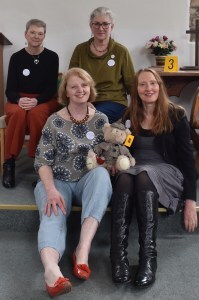 Left to right: the authors who spoke at the HULF Talk in April 2022 – back row Lucienne Boyce and Debbie Young, front row Valerie Keogh and A A Abbott (Photo by Laura Young)
Left to right: the authors who spoke at the HULF Talk in April 2022 – back row Lucienne Boyce and Debbie Young, front row Valerie Keogh and A A Abbott (Photo by Laura Young)To read Lucienne Boyce’s talk about The Victorian Origins of Crime Writing, you can now do so on her blog here:
https://francesca-scriblerus.blogspot.com/2022/05/the-victorian-origins-of-crime-writing.html
It has great illustrations too!
See www.hulitfest.com for more information about future HULF Talks.
April 27, 2022
The Curious Comfort of Unusual Books
 The code-loving Holmes would approve
The code-loving Holmes would approveA glance at the many bookshelves in my crowded cottage reveals that I’m an avid buyer of secondhand books. Not because I’m too mean to pay full price for new, but because I collect vintage curiosities. Most cost me pence rather than pounds. Their appeal is their eccentricity, not their market value. The most unusual book I own is Sir Arthur Conan Doyle’s The Return of Sherlock Holmes printed entirely in Pitman’s Shorthand. I can’t read shorthand, but I like to think keen code-breaker Sherlock Holmes would love it as much as I do.
My most recent acquisition is My Flying Scrap Book by Major CC Turner, the first professional journalist to gain a pilot’s licence. Published during the Second World War, his book draws on his 36 years of flying experience. Yes, 36. First airborne just five years after the Wright Brothers, he flew planes resembling the Kitty Hawk. He also travelled in hot air balloons and airships.
One of the many things I love about Major Turner’s book is that it conforms to the stringent standards of the Book Production War Economy Standard (BPWES) indicated by a patriotic lion-topped logo. Agreed between the Ministry of Supply and the Publishers’ Association, the BPWES code called for publishers to reduce paper usage by 60%, specified a minimum number of words per page and eliminated unnecessary white space.
 A suitably economical logo for War Economy Standard books
A suitably economical logo for War Economy Standard booksDespite thin, rough paper stock and light, plain covers, the books are very durable. My war-time editions of Dorothy L Sayers novels are almost as good as new, whereas my 1970s paperbacks are too frail to read.
The BPWES books are lightweight and slim, about a third as thick as modern paperbacks, and despite the small type, surprisingly easy on the eye.
Interestingly, the code did not constrain subject matter. While books considered essential to the war effort were allowed a more generous paper ration, all books were deemed worth publishing. I even have a BPWES book entitled A Book About Books, by Frederick Harrison, a fascinating jaunt through the history of books, reading and publishing.
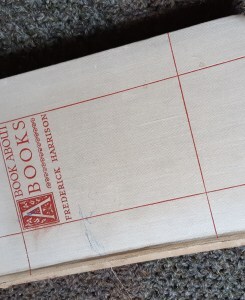 Still a covetable book despite stringent wartime production standards
Still a covetable book despite stringent wartime production standardsWhy don’t modern publishers emulate war-time practice to reduce paper use and shipping costs? As well as benefitting the environment, the slimmer format would enable booksellers to stock a wider range. Readers like me who are constantly running out of shelf-space would love them. The argument that plainer books would have less customer appeal does not convince me.
Even with their minimalist production standards, book sales grew during the war, because books provide comfort and escape from the horrors of the daily news – a sentiment we can still relate to today.
Books and reading will always help sustain people in adverse conditions, and if a society can keep producing books, and readers keep buying them, there is hope for us all. As Tove Jansson, writing her first Moomin book in war-torn Finland, has Moominmamma declare, “At last! Books! Now we’ll get by.”
This post was originally written for the April 2022 edition of the Tetbury Advertiser.
Secondhand Books in My BooksMy passion for secondhand and vintage books has spilled over into my fiction. In the fourth Sophie Sayers Village Mystery, Murder by the Book, Hector and Sophie snap up vintage books from a car boot sale in Clevedon, where they go to visit his parents, and one of these turns out to be a rare Gaelic volume which will be at the heart of the mystery in book 8, A Fling with Murder, which I’m about to start writing.
Order your copy of Murder by the Book here or ask for it at your local bookshop.
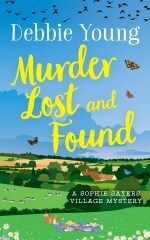 In Sophie’s most recent adventure, Murder Lost and Found, there is a sub-plot about Hector’s private collection of secondhand books, which Sophie is pressing him to turn into a commercial venture. When he employs a pretty young student to catalogue them for him, she begins to wonder whether this was such a good idea.
In Sophie’s most recent adventure, Murder Lost and Found, there is a sub-plot about Hector’s private collection of secondhand books, which Sophie is pressing him to turn into a commercial venture. When he employs a pretty young student to catalogue them for him, she begins to wonder whether this was such a good idea.
Order your copy of Murder Lost and Found here or ask for it at your local bookshop.
All seven of the Sophie Sayers Village Mysteries are available to buy in ebook for Kindle (free to Kindle Unlimited subscribers) and paperback online or to order from your favourite local bookshop.


